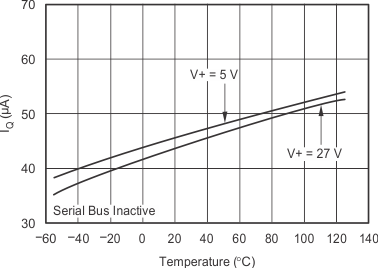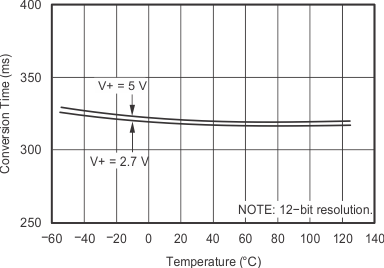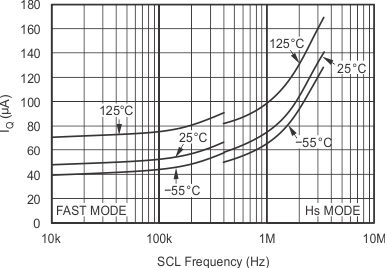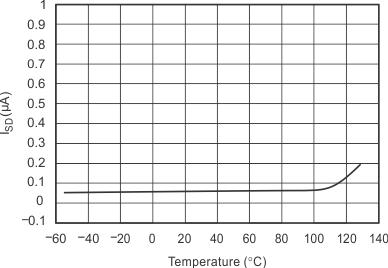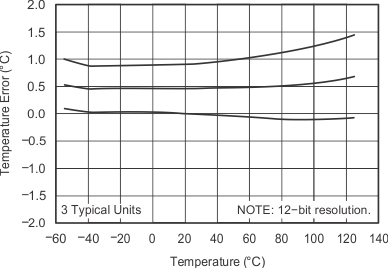SBOS231I January 2002 – November 2015 TMP100 , TMP101
PRODUCTION DATA.
- 1 Features
- 2 Applications
- 3 Description
- 4 Revision History
- 5 Pin Configuration and Functions
- 6 Specifications
-
7 Detailed Description
- 7.1 Overview
- 7.2 Functional Block Diagram
- 7.3 Feature Description
- 7.4 Device Functional Modes
- 7.5 Programming
- 8 Application and Implementation
- 9 Power Supply Recommendations
- 10Layout
- 11Device and Documentation Support
- 12Mechanical, Packaging, and Orderable Information
6 Specifications
6.1 Absolute Maximum Ratings
over operating free-air temperature range (unless otherwise noted)(1)| MIN | MAX | UNIT | ||
|---|---|---|---|---|
| Power supply, V+ | 7.5 | V | ||
| Input voltage(2) | –0.5 | 7.5 | V | |
| Operating temperature | –55 | 125 | °C | |
| Junction temperature, TJ | 150 | °C | ||
| Storage temperature, Tstg | –60 | 150 | °C | |
(1) Stresses beyond those listed under Absolute Maximum Ratings may cause permanent damage to the device. These are stress ratings only, which do not imply functional operation of the device at these or any other conditions beyond those indicated under Recommended Operating Conditions. Exposure to absolute-maximum-rated conditions for extended periods may affect device reliability.
(2) Input voltage rating applies to all TMP100 and TMP101 input voltages.
6.2 ESD Ratings
| VALUE | UNIT | |||
|---|---|---|---|---|
| V(ESD) | Electrostatic discharge | Human body model (HBM), per ANSI/ESDA/JEDEC JS-001(1) | ±2000 | V |
| Charged device model (CDM), per JEDEC specification JESD22-C101(2) | ±200 | |||
(1) JEDEC document JEP155 states that 500-V HBM allows safe manufacturing with a standard ESD control process.
(2) JEDEC document JEP157 states that 250-V CDM allows safe manufacturing with a standard ESD control process.
6.3 Recommended Operating Conditions
over operating free-air temperature range (unless otherwise noted)| MIN | NOM | MAX | UNIT | ||
|---|---|---|---|---|---|
| Supply voltage | 2.7 | 5.5 | V | ||
| Operating free-air temperature, TA | –55 | 125 | °C | ||
6.4 Thermal Information
| THERMAL METRIC(1) | TMP100, TMP101 | UNIT | ||
|---|---|---|---|---|
| DBV (SOT-23) | ||||
| 6 PINS | ||||
| RθJA | Junction-to-ambient thermal resistance | 182.9 | °C/W | |
| RθJC(top) | Junction-to-case (top) thermal resistance | 115 | °C/W | |
| RθJB | Junction-to-board thermal resistance | 30.2 | °C/W | |
| ψJT | Junction-to-top characterization parameter | 17.1 | °C/W | |
| ψJB | Junction-to-board characterization parameter | 29.7 | °C/W | |
(1) For more information about traditional and new thermal metrics, see the IC Package Thermal Metrics application report, SPRA953.
6.5 Electrical Characteristics
At TA = −55°C to 125°C and V+ = 2.7 V to 5.5 V, unless otherwise noted.| PARAMETER | TEST CONDITIONS | MIN | TYP | MAX | UNIT | ||
|---|---|---|---|---|---|---|---|
| TEMPERATURE INPUT | |||||||
| Range | –55 | 125 | °C | ||||
| Accuracy (temperature error) | −25°C to 85°C | ±0.5 | ±2 | °C | |||
| −55°C to 125°C | ±1 | ±2 | |||||
| Accuracy (temperature error) vs supply | 0.2 | ±0.5 | °C/V | ||||
| Resolution | Selectable | 0.0625 | °C | ||||
| DIGITAL INPUT/OUTPUT | |||||||
| Input capacitance | 3 | pF | |||||
| VIH | High-level input logic | 0.7 (V+) | 6 | V | |||
| VIL | Low-level input logic | −0.5 | 0.3 (V+) | V | |||
| IIN | Input current | 0 V ≤ VIN ≤ 6 V | 1 | µA | |||
| VOL | Low-level output logic SDA | IOL = 3 mA | 0 | 0.15 | 0.4 | V | |
| VOL | Low-level output logic ALERT | IOL = 4 mA | 0 | 0.15 | 0.4 | V | |
| Resolution | Selectable | 9 | 12 | Bits | |||
| Conversion time | 9 bits | 40 | 75 | ms | |||
| 10 bits | 80 | 150 | |||||
| 11 bits | 160 | 300 | |||||
| 12 bits | 320 | 600 | |||||
| Conversion rate | 9 bits | 25 | s/s | ||||
| 10 bits | 12 | ||||||
| 11 bits | 6 | ||||||
| 12 bits | 3 | ||||||
| POWER SUPPLY | |||||||
| Operating range | 2.7 | 5.5 | V | ||||
| IQ | Quiescent current | Serial bus inactive | 45 | 75 | µA | ||
| Serial bus active, SCL frequency = 400 kHz | 70 | ||||||
| Serial bus active, SCL frequency = 3.4 MHz | 150 | ||||||
| ISD | Shutdown current | Serial bus inactive | 0.1 | 13 | µA | ||
| Serial bus active, SCL frequency = 400 kHz | 20 | ||||||
| Serial bus active, SCL frequency = 3.4 MHz | 100 | ||||||
| TEMPERATURE RANGE | |||||||
| Specified range | –55 | 125 | °C | ||||
| Storage range | –60 | 150 | °C | ||||
6.6 Timing Requirements
6.7 Typical Characteristics
At TA = 25°C and V+ = 5 V, unless otherwise noted.